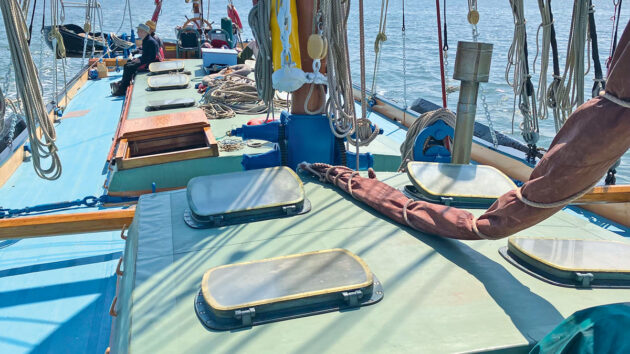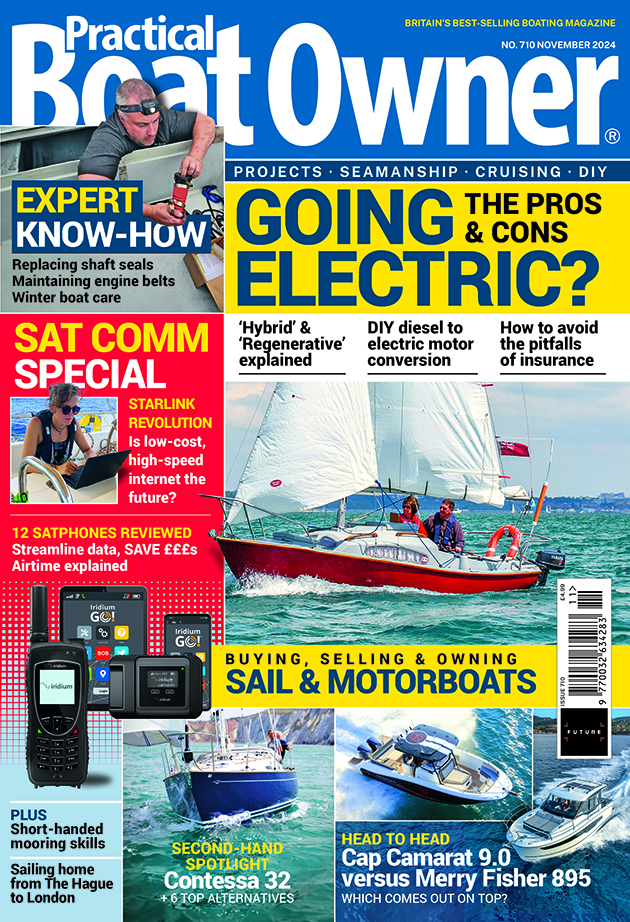Small-boat fanatic Clive has a day off his usual trailer-sailers to savour the wonderful and much bigger world of the Thames barge
One advantage of moving around the globe and changing jobs is that life is interesting.
A disadvantage might be that it keeps you financially poor with little pension. But even this may be considered an advantage because it keeps you working by necessity and the old brain ticking over.
So, at 75 I find myself still teaching and enjoying it and when talking to Steve, skipper and owner of the Thames barge Greta and a much younger man than me, I found a kindred spirit.
We need people like Steve to continually build their skills, pass them on and keep going to preserve our rich heritage of sailing craft.
Steve is doing a grand job with his 1892-built vessel – while introducing people to the wonderful world of Thames barges.

Lines aboard the Thames barge Greta. Credit: Clive Heathmarsh
When I met Steve and his two sea dogs at Whitstable he’d just brought Greta round from Faversham for the season.
He said Greta was a small sailing barge, but she looked massive to me.
Trips out to the estuary forts with up to 12 passengers help to pay for her upkeep but I suspect there can be no real profit for the owner other than having a great way to spend your days.
A modern steel ship will be lucky to last 25 years before she becomes razor blades and refrigerators.
Greta, made of oak planks on oak frames, is 132 years old and still going strong thanks to Steve and the people before him.
Prior to her current charter role, she carried cargo around the coast and up to London.

Clive with Steve, the owner and skipper of the Thames barge Greta. Credit: Clive Heathmarsh
During World War II, Greta worked for the Ministry of Supply and took part in the Dunkirk evacuation of 1940.
She sailed to Dunkirk again in 2000 for the 60th ‘Anniversaire Operation Dynamo’.
During peacetime, she has carried every cargo you can imagine, for much of her life without an engine.
I like traditionally-rigged sail boats and have even owned a 16-footer with a sprit sail, snotter and lee boards but the scale of Greta and her deck gear is something again.
They say that a barge can be sailed by just a man and a boy.
Well, just one look at all that rigging was enough to confuse me.
No doubt it would come eventually but Steve has to assume that his crew are all just passengers really and do things mainly by himself, from the engine room to the top of the masts.
The longevity of Greta is not unusual among the Thames barge population and bears testimony to their builders and English oak.

Whitstable harbour view from the Thames barge Greta. Credit: Clive Heathmarsh
Greta had also been blessed with luck to have escaped from Dunkirk and her years supplying dangerous munitions from the lower Thames.
Stepping aboard the first thing that hits you is how organised the ship is.
Everything is functional and smartly stowed. But things are heavy and largely controlled by winches. After a brief tour of the deck,
Steve showed me the quarters below. I could live here very comfortably. She even has a proper bathtub, not just a shower.
Plenty of headroom for me although I found a few of the hard oak beams between cabins.
I retired to my onshore accommodation (big sister’s flat) to return for casting off the following day at 1300.
At the quay, Steve introduced my wife and me to his very able-looking first mate, so I felt able to relax with Brenda on deck and enjoy the experience.
The fee was a fair £35 per passenger and in between his duties as captain and chief engineer,
Steve kept us refreshed with tea, coffee and snacks, leaving the mate on the wheel.
Whitstable harbour is a bit tight with commercial vessels and a fishing fleet. Just as we let go a fishing vessel decided to move at exactly the same time. They always do.
Not a problem for Steve and his mate who handled the ship with the skill that is acquired from living aboard.
I can be a bit rusty at the beginning of the season but not so for Steve.

Greta is made of oak planks on oak frames, and was built in 1892. Credit: Clive Heathmarsh
He has recently installed a large Perkins diesel engine but this auxiliary engine has her prop set off to one side and there are no bow-thrusters or dynamic positioning equipment on this classic, so manoeuvring was not as easy as they made it look.
We took a three-hour return passage out to a group of seven Maunsell Towers that were constructed at Gravesend and towed out into the estuary to protect the Thames highway to London.
The Redsand Towers are home to an osprey and many gulls.
They are six miles out from Whitstable and a small migratory bird had landed on them for a breather.
He took refuge on our cross trees before risking the osprey again by returning to the tower.
For much of the passage we were in shallow water but with our 3ft draught, we had little to worry about and, of course, Greta is designed to take the ground.
I’m old enough to remember seeing Thames Barges being worked with cargoes up the London river.
Wouldn’t it be good if this could start again? Indeed, Steve told me that one barge had recently carried a cargo.
I still believe that it’s best to own a little boat and hire or charter a big one when you feel the need.
The luxury of also having a skipper to take responsibility enables you to take time to look around the ship, put your feet up and take photos.
Being steady vessels they are ideal for taking friends who have not yet developed their sea legs.
I have previously taken customers on a Solent barge trip and also spent a night on the Thalatta, a larger barge sailing up the East Coast out of Maldon.
So why not give yourself a break and find a place on one of our barges, sit back and enjoy the ride or join in and help the crew?
The Thames barge Greta is available and ready for charters for parties of up to 12 persons. Details at: www.greta1892.co.uk
Want to read more articles like The beauty of the Thames barge Greta?

A subscription to Practical Boat Owner magazine costs around 40% less than the cover price.
Print and digital editions are available through Magazines Direct – where you can also find the latest deals.
PBO is packed with information to help you get the most from boat ownership – whether sail or power.
-
-
-
- Take your DIY skills to the next level with trusted advice on boat maintenance and repairs
- Impartial in-depth gear reviews
- Practical cruising tips for making the most of your time afloat
-
-
Follow us on Facebook, Instagram, TikTok and Twitter





